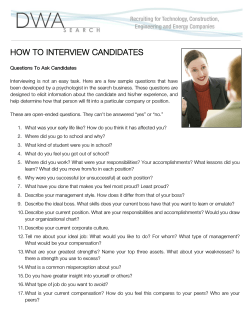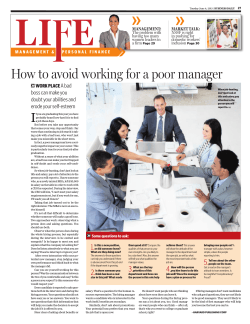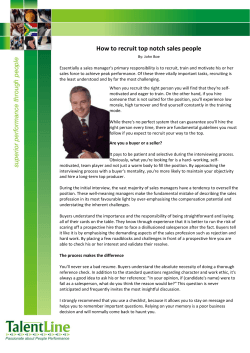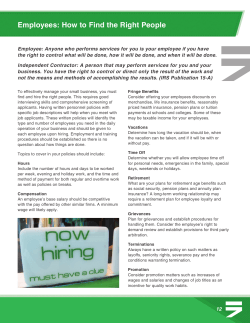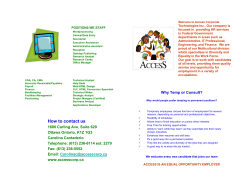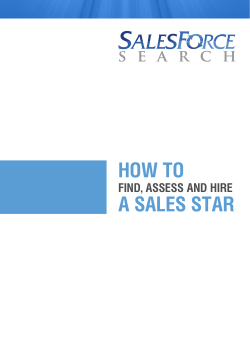
How to Hire Em ploy ees Ef fec tively
Volume 22 Number 12 1999 Biographical Note Both authors can be contacted at the Department of Management, School of Business Administration and Economics, California State University, Fullerton, Fullerton, California 92634-9480, USA. How to Hire Employees Effectively by Cynthia Sandico and Brian H. Kleiner What makes a good organisation? Good products, operational effectiveness, winning strategy...all these and more are borne out of people’s contributions. People make up an organisation; people are the lifeblood of a company. With today’s emphasis on leaner organisations, each employee is being called upon to play a critical role. With each new hire comes a promise of greater productiveness that is vital to the survival of an organisation. The Consequences of Hiring Mistakes The obvious bad hires are the ones who leave the job soon after they are hired. Other poor hires are not as apparent because the problem does not become noticeable until later: they are the clock-watchers, the incapables who get their work done by others, or the marginal workers who have found a way to beat the system. These are the “false positive” [4] employees, the people who were hired but should not have been. An example would be the person who does not get along well with others but is placed in customer service and alienates many customers resulting in lost future sales. The less visible problem of an ineffective hiring process is the “false negative,” the candidate who could have been effective on the job but was not hired. If this individual should work for the competition and makes valuable contributions there, the company not only lost a valuable employee but the competition has gained an edge. The cost of bad hiring is difficult to measure because the grossly mishired are only a small fraction of the total picture. If you think about the costs of the salary, wasted benefits, training costs, wasted time of the interviewers, effects on fellow employees, and the efficiency and opportunities lost due to the inferior work of the bad hire, it is not hard to see that the mistake can be measured in terms of tens to hundreds of thousands of dollars per hire. Yate [7, p.19] traces the cause of bad hires to one of the following reasons: poor analysis of job functions poor analysis of necessary personality-skill profile inadequate initial screening inadequate interviewing techniques inadequate questioning techniques poor utilisation of “second opinions” over- or inappropriately sold company and career/money expectations references not checked. 33 Management Research News Job and Task Analysis Most likely, a job description for the current open position is available in the Human Resources Department. As manager of the future hire, you should not rely on the completeness and accuracy of such description. It is to your benefit to analyse the current functions of your unit and the contributions that the current members make. The job requirement of the replacement may or may not match the old job description. Prepare a job analysis to help you determine what skills are really needed. A good job analysis as defined by Donald Weiss in How to be a Successful Interviewer [5] has four parts: Job Title, Objectives, Job Qualifications, and Tasks List. The job title identifies the position to be filled. The job objective describes the position’s contribution to the unit’s goals. It states what a person in that position has to accomplish; it specifies results. The position is evaluated in these terms so the search for the right person can begin. The job analysis also spells out what a person should bring to the job in order to do it well. Under job qualifications, minimum requirements, such as degree requirements or experience, are listed. Martin Yate [7] admonishes that the person you hire will not be the picture of perfection; no one is. Go through your functional demands and separate the “must-haves” from the “nice-to-haves” and consider the position’s level of interaction with other people or departments and any special skills this requires. Finally, by providing a listing of the primary tasks, the manager can decide on what skills are needed to do the job. The list of tasks explain how the objectives are reached and these tasks are listed with action verbs such as “draw wiring schematics on the computer” or “close and balance store registers” to determine competencies. The job and task analysis give the manager a good picture of the personality and skill profile required. Recruiting and Screening Recruitment is generally a function of a Human Resources department or agency. When appropriate, you as manager, can provide additional exposure of the job posting by providing access to professional organisations or listing it in the company newsletter. Your well written job analysis will provide assistance to the Human Resources staff in their screening process. If screening is indeed done by others, give yourself time to examine the ones that were rejected. You may find an interesting one that you may want to pursue. The role of your internal screening agents is to provide you with a wide array of suitable choices, so make sure that you give them every assistance to do just that [7, p.48]. 34 Volume 22 Number 12 1999 Testing Tips Human Resource staff have long relied on preemployment testing of skills required on the job to provide a gauge of a person’s ability to perform on the job. Examples of this are typing tests for typists, blue-print interpretation for draftsmen, and cash register tests for cashiers. A reliable testing programme involves several factors [3]: - an analysis of the knowledge, skills and other requirements that promote successful performance in a specific job - a decision as to which of those performance skills can be measured by a test - the selection of an appropriate test of those skills that has been validated by people performing the same job. Employers are testing more and more workers before and after they come on board. Honesty examinations in the banking industry is a way of life but preemployment drug testing still causes debate. Three rules should point you in the right direction [1]: - do not discriminate in testing or give the appearance of discrimination - become knowledgeable about the regulations and laws that govern your particular situation, and be aware of potential changes in the law - ensure that your testing methods, procedures, and administrators are of the highest quality. Public safety could mandate testing and an accurate assessment of job re sponsibilities and tasks may be important determinants of such need. For example, employees with access to controlled substances may be required to undergo drug testing as encouraged by the US Drug and Enforcement Administration (DEA). The Interview Before the interview, go over the resume or application that was used in the screening process and have it handy during the interview. Remember that the resume or application was written mainly to obtain an interview and will often claim exaggerations. During the interview you will want to know about gaps in employment dates, kinds (not just length) of experience, and performance history to determine if the applicant has the ability and motivation to do the job. Targeted Selection [2] techniques developed by William Byham trains interviewers to make hiring decisions by evaluating a person’s past job behaviours (acquired through interviews) and current behaviours (observed in simulation tests) against the dimensions (competencies) required for success in the open position. To understand past behaviour as a predictor of future behaviour, Byham developed the STAR method. First, obtain the Situation or Task that required the Action that gave the Result. For example, when a candidate states that she used her statistical skills in compiling various reports (Action), find out what the Situation or Task was. The reply could be that this was done when she was working on her undergraduate term paper and that she has not had the opportunity to do so in her present job. The Result was a grade of C. This may or may not be of major impor- 35 Management Research News tance depending on your needs but it illustrates how one statement may be changed radically by knowing the frame of reference. Swan [4] states that “what is at fault in bad interviewing...are the absence of tools, the well-thought-out systematic methods for obtaining pertinent information and properly assessing it once obtained.” Develop interview report forms to handle evaluations during and after each interview. The form will keep you on track and ensure that the interviewer covers the same scope with each applicant. Write the summary immediately after each candidate is interviewed. Many books and seminars are available to help you brush up on interviewing skills and they all agree that preparation is crucial. Without a clear picture of the job requirements, the interviewer could spend two hours with an individual and still be unable to make accurate judgements. The actual interview should be tailored to your special requirements. In all cases, as an interviewer, you must be aware of Equal Employment Opportunity laws so you do not expose your company and yourself to discrimination lawsuits. Limit your questions to those which are pertinent and important to the performance of the job. Word your questions so that they clearly relate to the job. During the interview, the applicant will provide a self-report. The individual’s honest self-appraisal may or may not be accurate and it is the interviewer’s responsibility to test and validate such information during the interview. Follow-up questions that probe why and how decisions were made give a broader picture. Ask how the accomplishment was achieved, how frustrations were resolved, what things were liked best or least about the situation, or why a certain job environment is preferred. It is also widely recommended that interviewers take notes. Writing down cue words that will trigger recollection immediately after the interview is a preferred method. Copious note taking is unnecessary and distractive. Another point worth considering is the 20% rule. Talk 20% of the time and give the applicant the other 80% to give you information. This will prevent you from giving too much data that the applicant can use to give you the “correct” response. The benefit of a “second opinion” or several interviewers’ opinions cannot be overemphasised. Many managers have the tendency to hire mirror images of themselves or to replicate the personnel being replaced. A competent second interviewer will provide the balance needed to ensure that the decision is not tainted by halo effect, bias, or prejudgement. Reference Checks Privacy issues and other legal baggage keep companies from routinely checking references. It is true that you could face a lawsuit from an unsuccessful applicant if you step over the line, but you run the risk of a bigger and nastier lawsuit if the maladjusted employee whose references you did not check harms or injures an innocent person [1]. Background checks weed out quacks and unauthorised workers but they also help identify the highest-quality applicants. 36 Volume 22 Number 12 1999 Conclusion Hiring the right employee requires good planning and execution of the various steps in the hiring procedure. Preparation at the front end may appear to be time consuming and costly but the costs of a bad hire will prove to be the more expensive alternative. A good job analysis will uncover the real requirements of the open position and is a better indicator of the new skills required than a job description that has been on file in Human Resources for several years. Screening and testing methods will depend in large measure to the job skills indicated in the job analysis. The interview provides the manager with the opportunity to probe deeper into the applicant profile shown in the resume. Good interview techniques that delve into the motivations and prior track record of the candidate will determine if the candidate is equipped with the necessary skills needed to be successful on the job. The use of a “second opinion” will help uncover a manager’s bias during the interview. Finally, reference checks will confirm or disprove candidates statements and will weed out the quacks or find the right match. References 1. Bequai, A., Every Manager’s Legal Guide to Hiring, Dow-Jones-Irwin, Homewood, Illinois, 1990. 2. Byham, W.C., The Selection Solution, DDI Press, Pennsylvania, 1996. 3. Dobrish, C., Wolff, R. and Zevnik, B., Hiring the Right Person for the Right Job, Franklin Watts, New York, 1984. 4. Swan, W.S., Swan’s How to Pick the Right People Program, John Wiley & Sons, New York, 1989. 5. Weiss, D.H., How to be a Successful Interviewer, AMACOM, New York, 1988. 6. Wendover, R.W., Smart Hiring for Your Business, Sourcebooks Trade, Illinois, 1993. 7. Yate, M.J., Hiring the Best, Bob Adams Inc., Boston, 1987. 37
© Copyright 2025





